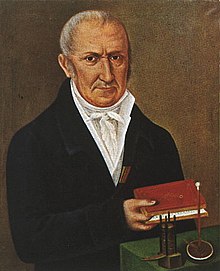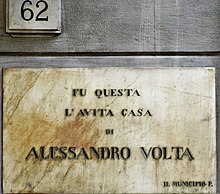Alessandro Volta
Alessandro Giuseppe Antonio Anastasio Volta , from 1810 Count von Volta (born February 18, 1745 in Como , † March 5, 1827 ibid) was an Italian physicist . He is considered to be the inventor of the electric battery and one of the founders of electricity .
life and work
Volta was born as the son of a wealthy family in Como in what was then Habsburg northern Italy as one of nine children, five of whom - like some uncles - became priests. The father himself was a Jesuit novice for a long time. Volta's parents, Filippo Volta and Maria Maddalena dei Conti Inzaghi, had planned a different career for Volta and sent him to a Jesuit school from 1758 to 1760 in preparation for a legal career . In self-study he studied books on electricity ( Pieter van Musschenbroek , Jean-Antoine Nollet , Giambatista Beccaria ) and corresponded with leading scholars. Turin physics professor Beccaria advised him to concentrate on experimental work. In 1769 he published his first physical work, which was already criticizing the authorities. In 1775 his fame grew with the invention of the electrophore , which was soon used all over Europe , with which static electricity generated by influence could be generated and transported. In 1774 he was appointed superintendent and director of the state schools in Como. As early as 1775 he was appointed professor for experimental physics at the school in Como. In 1776 he was the first to discover methane in gas bubbles rising from the swamps on Lake Maggiore and began to experiment with flammable gas (volta pistol in which an electric spark in a bottle triggers combustion, i.e. a kind of gas lighter). With it he constructed constantly burning lamps and used his Volta pistol as a measuring device for the oxygen content of gases ( eudiometer ).
All these discoveries led to his being appointed professor of physics in 1778 (after a trip to Switzerland in 1777, where he met Voltaire , among others ) and until 1819 professor of experimental physics at the University of Pavia .
There he invented an (“straw”) electroscope for measuring the smallest amounts of electricity (1783), quantified the measurements by introducing his own voltage units (the word “voltage” comes from him) and formulated the proportionality of the charge and voltage in the capacitor .
In 1792 he learned of the frog experiments of the respected anatomist Luigi Galvani , which he traced back to animal electricity. However, Volta recognized the cause of the muscle twitching in external tensions (such as contact electricity , if several metals were experimented with), and a dispute arose over galvanism , which scientists across Europe divided into camps. For Galvani, the explanation was that the frog was a kind of Leyden bottle (i.e. a capacitor), for Volta it was just a kind of detector. It is still important today that this resulted in Volta's longstanding research into contact electricity, and ultimately his groundbreaking invention of the battery.
Volta is also said to have anticipated the idea of the telegraph and the Gay-Lussac law (volume expansion of gases proportional to temperature) in his writings .
His greatest and most successful invention, however, was the voltaic column constructed around 1800 , the first functioning battery (after he had already examined electrical voltage series of various metals in the 1790s). It consisted of elements layered one on top of the other, each consisting of a copper plate and a zinc plate, which were separated from each other by textiles that had been soaked with acid (initially water or brine). He describes the invention in a famous letter written on March 20, 1800 to Sir Joseph Banks of the Royal Society in London. It was only with this invention of the battery that further research into the magnetic properties of electrical currents and the application of electricity in chemistry made possible in the following century.
In 1791 the Royal Society appointed him a member and in 1794 awarded him their Copley Medal . In 1792 he went on his second trip abroad, during which he a. a. Pierre Simon Laplace , Antoine Laurent de Lavoisier in Paris, where he had been a member of the Académie des Sciences since 1782 , and Georg Christoph Lichtenberg in Göttingen . In 1801 he traveled to Paris, where he demonstrated his battery to Napoleon Bonaparte on November 7th .
In 1802 he received the Gold Medal of Honor from the Institut de France and a pension from Napoleon. In 1805 he was elected a foreign member of the Göttingen Academy of Sciences . Since 1808 he was a foreign member of the Bavarian Academy of Sciences . After Napoleon had conquered Italy, he appointed Volta, who actually wanted to retire at that time, senator in 1809 and raised him to the rank of count in 1810. After the invention of the battery, he increasingly gave up research and teaching, but was persuaded by his appointment as dean of the philosophical faculty in 1813 to stay until his final retirement in 1819. In 1820 he was elected a member of the Royal Society of Edinburgh . His career had survived the changing power relations unscathed - he was in favor of both the Habsburgs and Napoleon. In retirement, he moved to his country house in Camnago near Como.

After living with the singer Marianna Paris for many years, Volta married the wealthy Teresa Peregrini in 1794, with whom he raised two sons. He is buried in Camnago , a district of Como that has been called Camnago Volta since 1863 . There you can also see his instruments in the Tempio Voltiano Museum.
Named after Volta
In the 19th century, Volta was honored with what is probably the highest distinction that a physicist can bestow: In his honor, the unit of measurement for electrical voltage was given the international name of volt . This was first proposed in 1861 by a committee of the British Association for the Advancement of Science.
In 1964 the lunar crater Volta was named after him, in 1999 the asteroid (8208) Volta and also the district heating power plant Volta in Basel (1980).
The company Isovolta provides since 1949 electrical insulating materials in Austria forth. The electric eel species Electrophorus voltai was first described in 2019 .
Commemoration

Alessandro Volta was depicted on the last Italian 10,000 lire banknote issued by the Banca d'Italia between 1984 and 2001.
Fonts
- F. Massardi (Editor): Alessandro Volta. Epistolario , 5 volumes, Bologna, Zanichelli, 1949–1955 (letters)
- Allessandro Volta: Le Opere. 7 volumes, Hoepli, Milan 1918–1929 (Reprint: Johnson, New York 1968)
- Aloisius Galvani : Treatise on the forces of electricity in muscle movement (Comm. Bonon. Sc. Et Art. Inst. Et Acad. T. 7; 1791, original title: De viribus electricitatis in motu musculari commentarius ), edited by AJ von Oettingen, 2nd ed., Repr. Of the ed. Leipzig, Engelmann, 1894 and 1900. German, Thun / Frankfurt am Main 1996, ISBN 3-8171-3052-X (also contains: Alessandro Volta: Studies on Galvanism (1796–1800 ), earlier than: Ostwald's Classics of Exact Sciences ; Vol. 52 and 118).
See also
literature
- Volta, Alessandro Giuseppe Antonio Anastasio. In: Kevin Desmond: Innovators in Battery Technology: Profiles of 95 Influential Electrochemists , McFarland, 2016, ISBN 978-0-7864-9933-5 , pp. 231-235
- Geoffrey Sutton The politics of science in early Napoleonic France: the case of the voltaic pile. In: Historical studies in the physical sciences. Volume 11, 1981, pp. 329-366
- Emilio Segrè : From falling bodies to electromagnetic waves (= The great physicists and their discoveries. Volume 1), Piper, Munich / Zurich 1986, ISBN 3-492-11174-2 .
- Marcello Pera: The ambigious frog: the Galvano-Volta controversy on animal electricity. Princeton University Press 1992.
- John Heilbron : Alessandro Volta . In: Charles Coulston Gillispie (Ed.): Dictionary of Scientific Biography . tape 14 : Addison Emery Verrill - Johann Zwelfer . Charles Scribner's Sons, New York 1976, p. 69-82 .
- John Heilbron: Electricity in the 17th and 18th centuries. University of California Press 1979, Dover 1999.
- Anna Märker: Volta, Alessandro Giuseppe Antonio Anastasio. In: Werner E. Gerabek , Bernhard D. Haage, Gundolf Keil , Wolfgang Wegner (eds.): Enzyklopädie Medizingeschichte. Volume 3, De Gruyter, Berlin / New York 2007, ISBN 978-3-11-019703-7 , p. 1459
- Giuliano Pancaldi: Volta: Science and Culture in the Age of Enlightenment. Princeton University Press 2005.
- Kurt Jäger, Friedrich Heilbronner: Lexicon of electrical engineers . 2nd Edition. VDE-Verlag, 2010, ISBN 978-3-8007-2903-6 , p. 444–445 ( vde-verlag.de [PDF; 125 kB ] table of contents).
- Concise Dictionary of Scientific Biography. Charles Scribner's Sons, New York 1981, ISBN 0-684-16650-X , pp. 712-714.
- Michèle Stäuble-Lipman Wulf: Alessandro Volta. In: Historical Lexicon of Switzerland . December 27, 2014 , accessed March 4, 2020 .
Web links
- Literature by and about Alessandro Volta in the catalog of the German National Library
- Work edition (Ditigalisat, Italian)
- Detailed biography of the University of Pavia, English
- Tempio Voltiano Museum (Alessandro Volta Museum)
- Digitized works by Volta - SICD of the Universities of Strasbourg
- Wolfgang Burgmer: February 18th, 1745 - birthday of Alessandro Volta WDR ZeitZeichen on February 18th, 2020 (podcast)
Individual evidence
- ↑ Guiliano Pancaldi, Volta. Science and Culture in the Age of Enlightenment , Princeton 2003, p. 326.
- ^ List of former members since 1666: Letter V. Académie des sciences, accessed on March 13, 2020 (French).
- ↑ November 7, 1801 - The first battery is presented: "Artificial electrical organ" , WDR 2 , deadline of November 7, 2011
- ↑ Holger Krahnke: The members of the Academy of Sciences in Göttingen 1751-2001 (= Treatises of the Academy of Sciences in Göttingen, Philological-Historical Class. Volume 3, Vol. 246 = Treatises of the Academy of Sciences in Göttingen, Mathematical-Physical Class. Episode 3, vol. 50). Vandenhoeck & Ruprecht, Göttingen 2001, ISBN 3-525-82516-1 , p. 249.
- ^ Fellows Directory. Biographical Index: Former RSE Fellows 1783–2002. (PDF file) Royal Society of Edinburgh, accessed April 19, 2020 .
- ^ Regio Decreto April 21, 1863, n.1273
- ^ IEEE Global History: System of Measurement Units
- ↑ Minor Planet Circ. 34627
| personal data | |
|---|---|
| SURNAME | Volta, Alessandro |
| ALTERNATIVE NAMES | Volta, Alessandro Giuseppe Antonio Anastasio Count of (full name) |
| BRIEF DESCRIPTION | Italian physicist, founder of electricity |
| DATE OF BIRTH | February 18, 1745 |
| PLACE OF BIRTH | Como |
| DATE OF DEATH | March 5, 1827 |
| Place of death | Camnago Volta |



